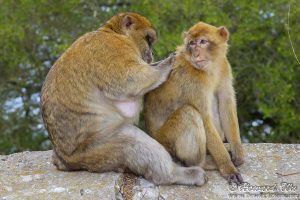Scientific name: Macaca sylvanus
Conservation status:
Life expectancy: About 20 years in wild (females generally live longer)
Gestation period: 147-192 days
Other names: Barbary ape, Rock ape and Common macaque.
xxxxxxxxxxxxxxxxxxxxxxxxxxxxxxxxxxxxxx
Lifestyle and Location:
- They have a small population in Gibraltar, however, most live in forests in Morocco and Northern Algeria.
- They are also known as Barbary apes because they have no tail (a common feature between apes).
- They live in groups of up to 100 individuals.
- What makes them different from other macaques is that the male helps look after the young by grooming and playing with them.
- Another unique feature of theirs is not living in Asia like the other macaques.
- Their diet includes different insects and plants. When they eat the plants they eat the flowers, fruits, seeds, seedlings, leaves, buds, bark, gum, stems, roots, bulbs and corns. This is practically all the plant and when they eat living animals they eat things like, moths, butterflies, centipedes, tadpoles, ants, spiders and more. They aren’t fussy about anything!
Appearance:
These macaque are yellowish-brown or grey in colour with a noticeable lighter colour on their underside. The females have a body length on average of 55.6 cm and weigh around 10.3 kg but the males are bigger with an average body length of 63.4 cm and weighing 14.5 kg.
Joss‘s Facts
- These monkeys are the only non-human primate found wild in the whole of Europe!
- Instead of hugging to improve social bonds and status, the males tend to steal young off females and bring it to another male who is higher in ranks and use the baby as a kind of offering, no one is sure why they do this but it seems to work. (they also groom to improve bonds)
- They have very large cheek pouches that can hold as much food their stomach can !
